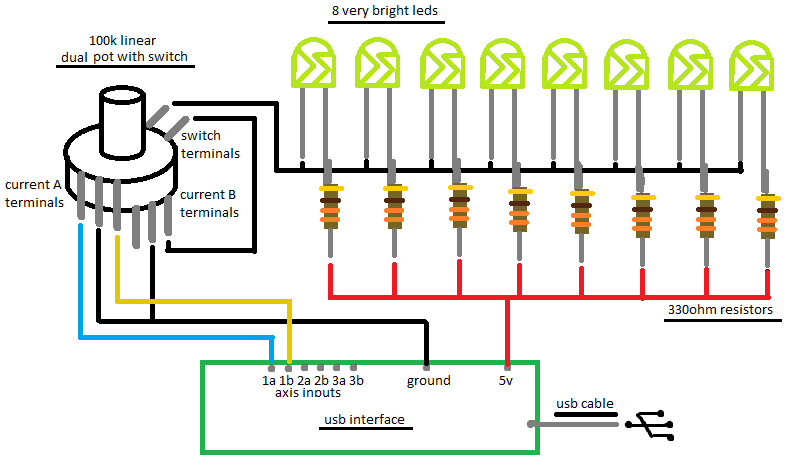fael097
Newbie level 6
Hey,
I'm new to these forums, or to not-basic electronics in general, so I have no idea where's the correct place to post this thread, but in case it's not here, please move it to the appropriate section.
I'm creating a home made cockpit for playing flight sims, so for the first panel, I took the usb interface from an old joystick (12 buttons, 4 axis, POV hat, force feedback) and connected some switches to it. so far it's working, but I wanted to go further, and have some LED lights attached to a potentiometer that would control both real lights in my panel, and the lights in game through an axis.
So, I have some problems:
1st, I connected a regular potentiometer (I have no Idea how many Ks) to all my leds. it works sort of well, except they are always on, dim, but on, and also, they are not equally bright as I raise the intensity through the pot. when its on max/min, they appear to be equally bright, but not in-between.
this is the least of my problems, I bought a pot with a switch, and i resolved the problem of always on. about the difference of intensity, that doesn't bothers me that much right now, so I left it like that while I dont find a solution.
the bigger problems:
I wanted to connect the pot to the usb interface, not only to power. some guys told me if I connect the 5v and the interface on the same pot pin, it might damage the whole thing, and I'd need a dual pot. I even bought a pot with a switch, to be able to turn the leds off, but that doesnt help, since I'd need a dual pot with a switch.
since I don't have a dual pot atm, I disconnected everything, and tried to use the pot hooked to the usb interface, to see if I can control the axis. turns out that it simply doesn't work as the pots that come with the joystick. i only have a milimetric portion of the pot's rotation that affect the axis, the rest of it keep the axis on 0, and a tiny bit moves it to 1. (nothing compared to the 0 to 100 that I should have from the beggining to the end of the pot's rotation). I believe that's because I'd need a pot with specific number of Ks, and linear or logarythimic, but IDK what exactly, what I have, and not even sure if that's really the problem.
so I'd need a dual pot, with switch, certain number of Ks, and linear or logarythimic, dont know which one. turns out that I can't find any pots with all these attributes.
that's why I'm asking for help, I'm so confused about all this stuff. :-?
thanks in advance!
I'm new to these forums, or to not-basic electronics in general, so I have no idea where's the correct place to post this thread, but in case it's not here, please move it to the appropriate section.
I'm creating a home made cockpit for playing flight sims, so for the first panel, I took the usb interface from an old joystick (12 buttons, 4 axis, POV hat, force feedback) and connected some switches to it. so far it's working, but I wanted to go further, and have some LED lights attached to a potentiometer that would control both real lights in my panel, and the lights in game through an axis.
So, I have some problems:
1st, I connected a regular potentiometer (I have no Idea how many Ks) to all my leds. it works sort of well, except they are always on, dim, but on, and also, they are not equally bright as I raise the intensity through the pot. when its on max/min, they appear to be equally bright, but not in-between.
this is the least of my problems, I bought a pot with a switch, and i resolved the problem of always on. about the difference of intensity, that doesn't bothers me that much right now, so I left it like that while I dont find a solution.
the bigger problems:
I wanted to connect the pot to the usb interface, not only to power. some guys told me if I connect the 5v and the interface on the same pot pin, it might damage the whole thing, and I'd need a dual pot. I even bought a pot with a switch, to be able to turn the leds off, but that doesnt help, since I'd need a dual pot with a switch.
since I don't have a dual pot atm, I disconnected everything, and tried to use the pot hooked to the usb interface, to see if I can control the axis. turns out that it simply doesn't work as the pots that come with the joystick. i only have a milimetric portion of the pot's rotation that affect the axis, the rest of it keep the axis on 0, and a tiny bit moves it to 1. (nothing compared to the 0 to 100 that I should have from the beggining to the end of the pot's rotation). I believe that's because I'd need a pot with specific number of Ks, and linear or logarythimic, but IDK what exactly, what I have, and not even sure if that's really the problem.
so I'd need a dual pot, with switch, certain number of Ks, and linear or logarythimic, dont know which one. turns out that I can't find any pots with all these attributes.
that's why I'm asking for help, I'm so confused about all this stuff. :-?
thanks in advance!


